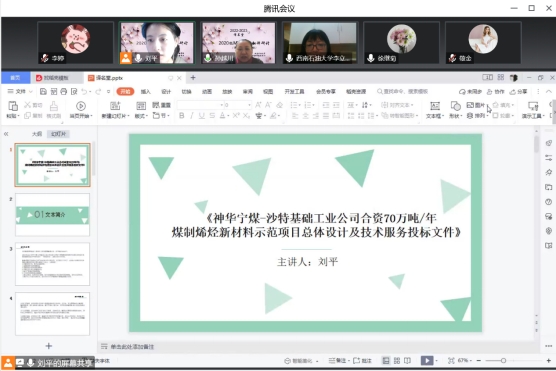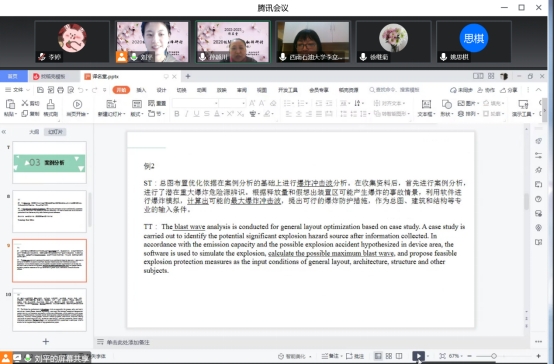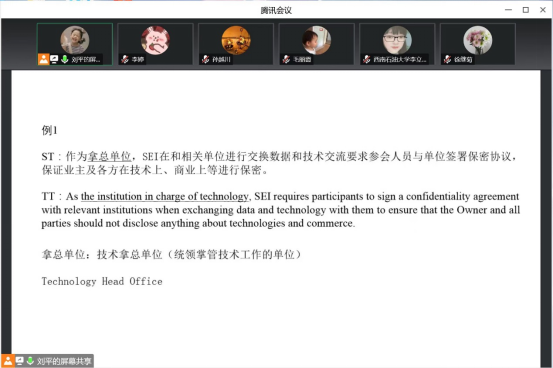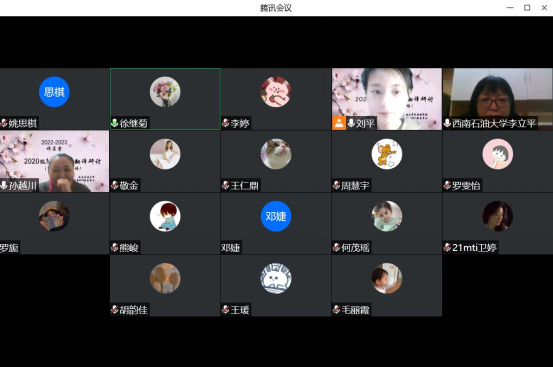汇报时间:2022年12月15日18:30-20:00
汇报地点:腾讯会议541 140 904
汇报学生:刘平
指导教师:李立平
汇报题目:《神华宁煤-沙特基础工业公司合资70万吨/年煤制烯烃新材料示范项目总体设计及技术服务投标文件》(第二部分节选)汉英翻译实践报告
参与导师:李立平,孙越川,徐继菊
内容简介:
翻译材料选自《神华宁煤-沙特基础工业公司合资70万吨/年煤制烯烃新材料示范项目总体设计及技术服务投标文件》中第二部分节选(第8.6节至第10.4节),以投标人开展的相关采购技术服务和现场工程的准备工作为主,主要包括:1.质量管理计划、程序及保障措施;2.进度控制计划及保障措施;3.沟通管理计划/界面管理程序;4.提供交付物及文档管理计划;5.知识产权保护及保密措施;6.对工作范围和技术要求的偏离;7.建议及意见,如项目执行策略,限额设计及投资优化控制措施,从设计优化、工程优化入手进行投资优化,HAZOP审查和三维模型审查方法等。
在翻译该文本的过程中遇到的难点具体如下:
1. 专业术语&专业知识:工程标书类专业知识欠缺,且文本中存在大量专业术语和投标文件固定表达,目前掌握的术语库还不够全面,造成对原文理解不清,导致译文错译。
2. 长难句:该翻译材料中存在大量长难句,一逗到底,结构冗杂,逻辑混乱,需要按照英文表达习惯对原文进行长句拆分断句,调整语序,梳理行文逻辑。
3. 图表处理:大批量图表处理,中英对照美观度问题凸显;表中存在大量无主语句,需要谨慎采用被动语态、形式主语句式和祈使句型,保持投标文件严肃的文体风格。
译文修改:
例1:
ST: 总图布置优化依据在案例分析的基础上进行爆炸冲击波分析。在收集资料后,首先进行案例分析,进行了潜在重大爆炸危险源辨识。根据释放量和假想出装置区可能产生爆炸的事故情景,利用软件进行爆炸模拟,计算出可能的最大爆炸冲击波,提出可行的爆炸防护措施,作为总图、建筑和结构等专业的输入条件。
TT1: The blast wave analysis is conducted for general layout optimization based on case study. A case study is carried out to identify the potential significant explosion hazard source after information collected. In accordance with the emission capacity and the possible explosion accident hypothesized in device area, the software is used to simulate the explosion, calculate the possible maximum blast wave, and propose feasible explosion protection measures as the input conditions of general layout, architecture, structure and other subjects.
TT2: The explosive blast wave is conducted for general layout optimization based on case study. A case study and the potential major explosive hazard identification are carried out after information collected. In accordance with the emission capacity and the possible explosion accident hypothesized in device area, the software is used to simulate the explosion to calculate the value of the maximum possible explosive blast wave, so that feasible explosion protection measures are proposed, which are considered as the input conditions for general layout, architecture, structure and other subjects.
例2:
ST: 为了展现投标人对所投装置不同工艺路线丰富的工程业绩,并满足招标人在标书中提出了与招标人类似规模装置不同工艺技术方案与技术选型方案内容的要求,投标人就不同工艺技术路线的特点、执行过程中需要注意的关键点、长周期供货、投资和占地、公用工程消耗等简要可提供数据内容供招标人参考,协助招标人确定最适合的工艺技术路线,无论招标人采取何种工艺路线,投标人均可以提供最优,最快服务;
TT1: In order to show our excellent engineering achievements in the devices the bidder has invested for the different process routes and meet the requirements purchaser proposed in the bidding document about different process and technology scheme and technical selection scheme of the device with similar scale, the bidder shall provide data content to assist the purchaser in determining the most suitable process and technology route in accordance with the characteristics of different process and technology routes, key points, long-period supply, investment and land occupation, utility cost and others requiring for attention in executing. No matter what process route purchaser adopts, the bidder can provide the best and fastest service;
TT2: The bidder shows excellent engineering achievements in the devices the bidder has invested for the different process routes and meets the requirements purchaser proposed in the bidding document about different process and technology scheme and technical selection scheme of the device with similar scale. The bidder shall provide data content to assist the purchaser in determining the most suitable process and technology route in accordance with the characteristics of different process and technology routes, key points, long-period supply, investment and land occupation, utility cost and others requiring for attention in executing. No matter what process route purchaser adopts, the bidder can provide the best and fastest service;
例3:
ST: 全厂污水治理通过压缩污水排放量、清污分流、分类处理等手段进行处理,处理后净水回用。
TT1: The sewage of the whole factory is treated through sewage discharge compression, diverting wastewater from clean water, and classified treatment. Then purified water is reused after treatment.
TT2: The sewage of the whole factory is treated through compressed sewage discharge, diverting wastewater from clean water, and classification. Treated water can be reused.
研讨反思:
通过此次翻译研讨,对翻译的过程有了更加清楚的认识,主要收获如下:
第一、主语一致性问题较为突出。在探讨过程中,老师们反复提到一个问题:主语不一致。该翻译材料的长难句非常多,比如说上述的第2个例子。中文结构杂糅,如果不仔细分析,会很容易被原文句式框住,译者将很难准确的主语,英文译文难以翻译得比较地道。
第二、翻译重复啰嗦。在翻译研讨过程中,老师发现中文句子写的很啰嗦,没有逻辑性,译者的译文也很啰嗦,很多是字对字的翻译,译者没有跳出中文句式的框架,导致目的语读者难以理解译文,所以我们要保证译文在传达出准确意义的基础上还要体现表达的简洁性。



